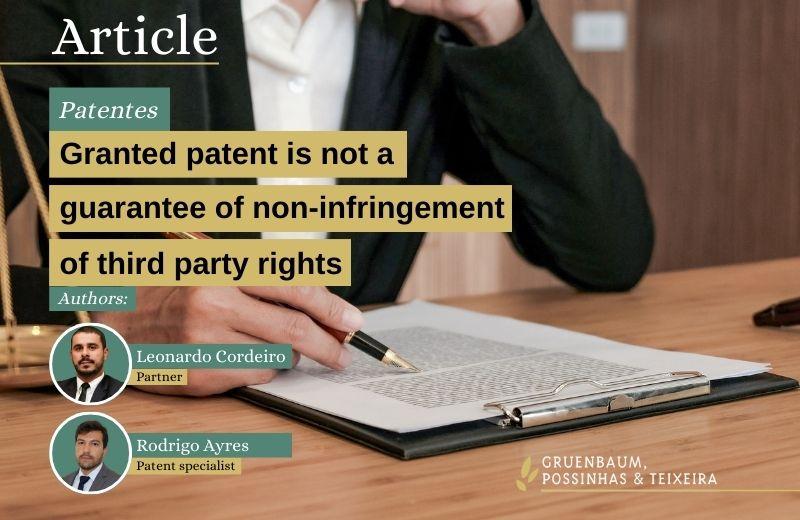A granted patent is not a guarantee of non-infringement of third party rights

A patent granted for a product or process is not a guarantee that the exploitation or commercialization of such content will not infringe a patent of a competitor, say patent specialists Rodrigo Ayres and Leonardo Cordeiro from the Brazilian IP Law firm Gruenbaum, Possinhas & Teixeira.
Recently, the 3rd Panel of the Superior Court of Justice (STJ) judged a patent infringement case, in which the plaintiff alleges that the defendant company is violating its rights by marketing a type of modular block for vertical forests that is identical to the product protected by the plaintiff’s invention patent. The defendant company, in turn, maintains that it has a utility model patent for its product, granted by the National Institute of Industrial Property (INPI – Brazilian PTO) and, as such, the use of this product would not infringe the plaintiffs’ patent of invention. The São Paulo Court of Justice (TJ/SP) considered that the products were practically identical. The 3rd Panel of the STJ returned the case to the second instance court for a detailed analysis and comparison of the products and their patents [1].
Firstly, it is worth clarifying that a utility model (MU) patent has a protection term of 15 years counted from the filing date and, in accordance with Article 9 of the Brazilian Industrial Property Law (IPL) [2], it is granted for an “object of practical use, or part thereof, susceptible of industrial application, which presents a new shape or arrangement, and involves an inventive act that results in a functional improvement in its use or manufacture”. In other words, it is an improvement on a known object, with its protection restricted to the technical and/or functional aspects brought about by the shape or arrangement of the object. Differently, a patent of invention (PI) denotes an original creation, associated with a new technical effect (inventive step), representing more comprehensive innovations and not restricted to the shape or arrangement of a given object. A patent of invention has a term of 20 years.
Usually, patent infringement analysis must be done by comparing the technical features of the allegedly infringing product with the technical features described in the independent claims of the allegedly infringed patent.
In this case, in particular, it is important to examine the defendant’s product in detail, and verify whether the technical features of such product and the functional improvements described in its utility model patent overlap with elements protected by the plaintiff’s patent of invention, that is, assess whether the object of the plaintiff’s patent of invention (which is in force and is prior to the defendant’s utility model patent) is being used in the product sold by the defendant, which could constitute an infringement of the plaintiff’s industrial property rights.
The point is that the recognition of a functional improvement of the object/product by the BPTO and the consequent granting of a utility model patent do not exclude the possibility that the exploitation of such object/product constitutes an infringement of a competitor’s prior and in force patent.
Hence, a patent granted, according to Article 42 of the IPL [2], is not a “monopoly” but rather a “right to prevent third parties from manufacturing, using, offering for sale, selling or importing for such purposes without his consent”. Therefore, for patent infringement analysis purposes, it is very important to pay attention to this fact, always noting the relation between the granted patent and the prior patent in force. If the prior patent is not in force, then it will already be in public domain and, obviously, there will be no possibility of infringement discussion.
SOURCES:
[1] Patente de modelo de utilidade não exclui violação de invenção principal. Consultor jurídico | BR | Marco regulatório | INPI. Página 9. Brasília, 09 de janeiro de 2024. Disponível em: https://www.conjur.com.br/2024-jan-09/patente-de-modelo-de-utilidade-nao-exclui-violacao-de-invencao-principal/#:~:text=Patente%20de%20modelo%20de%20utilidade%20n%C3%A3o%20exclui%20viola%C3%A7%C3%A3o%20da%20patente%20de%20inven%C3%A7%C3%A3o%20principal&text=Editorias%3A,principal%20n%C3%A3o%20tenha%20sido%20violada.
[2] LEI Nº 9.279, DE 14 DE MAIO DE 1996. LEI DE PROPRIEDADE INDUSTRIAL. Disponível em: https://www.planalto.gov.br/ccivil_03/leis/l9279.htm.
